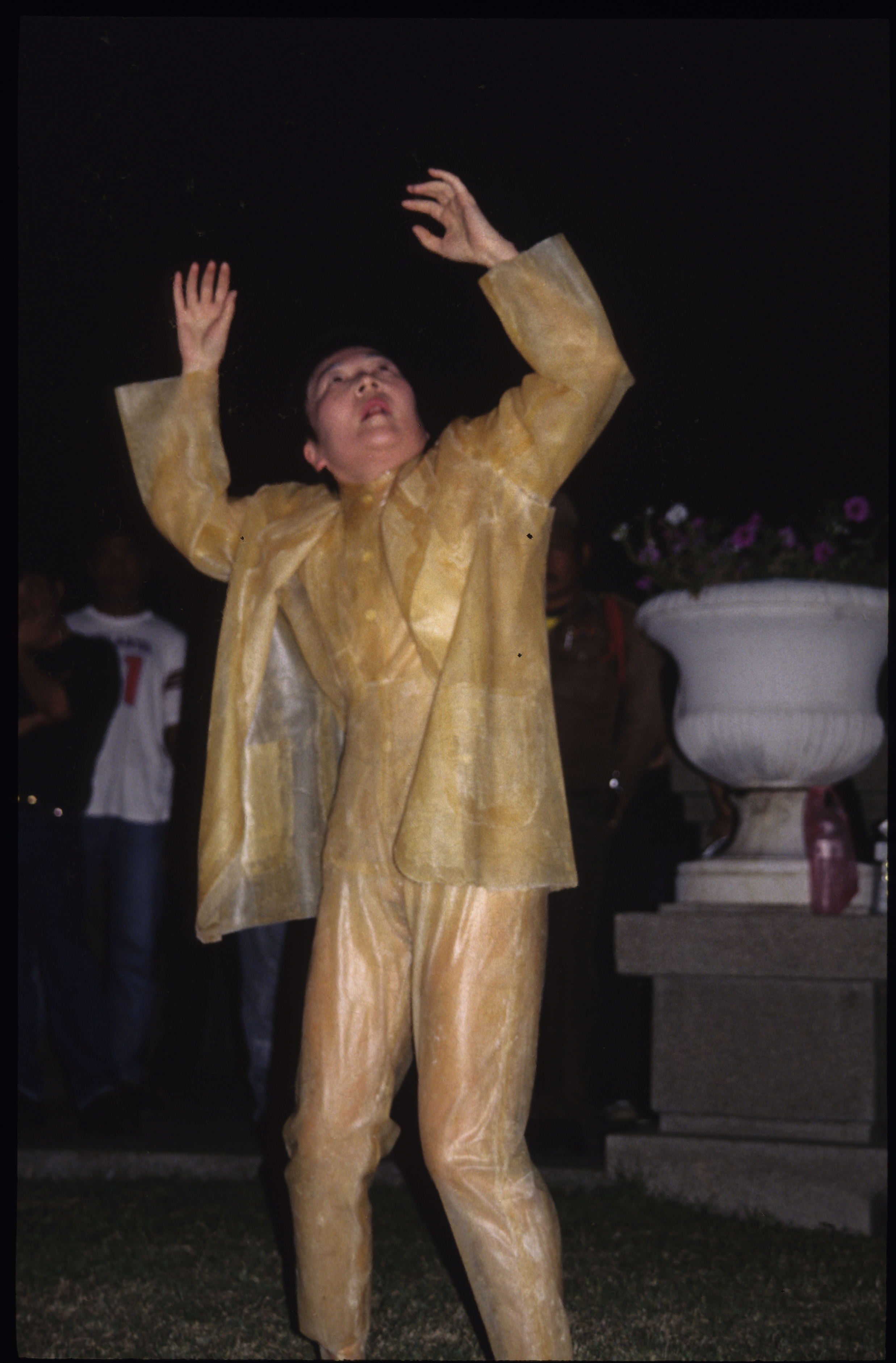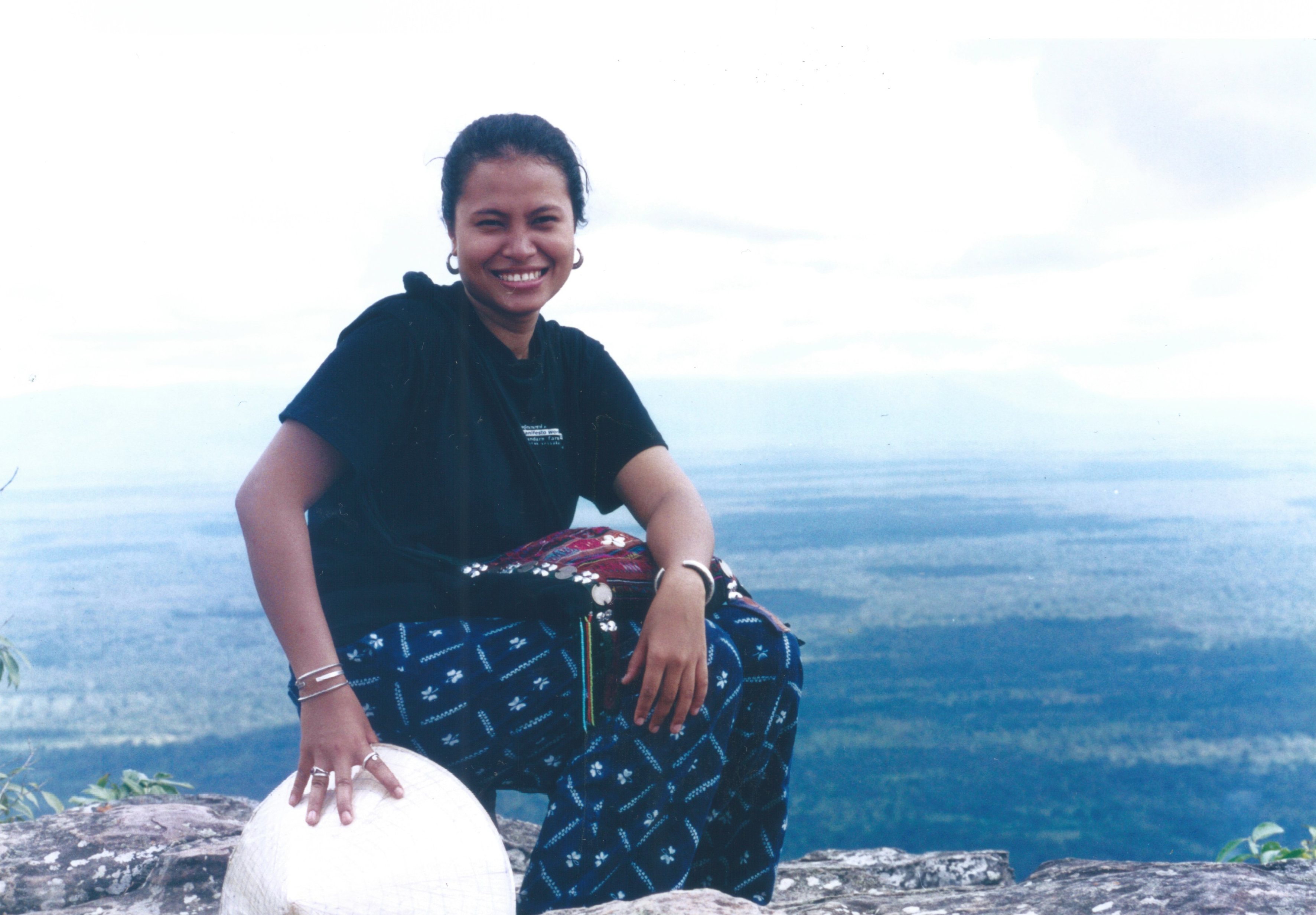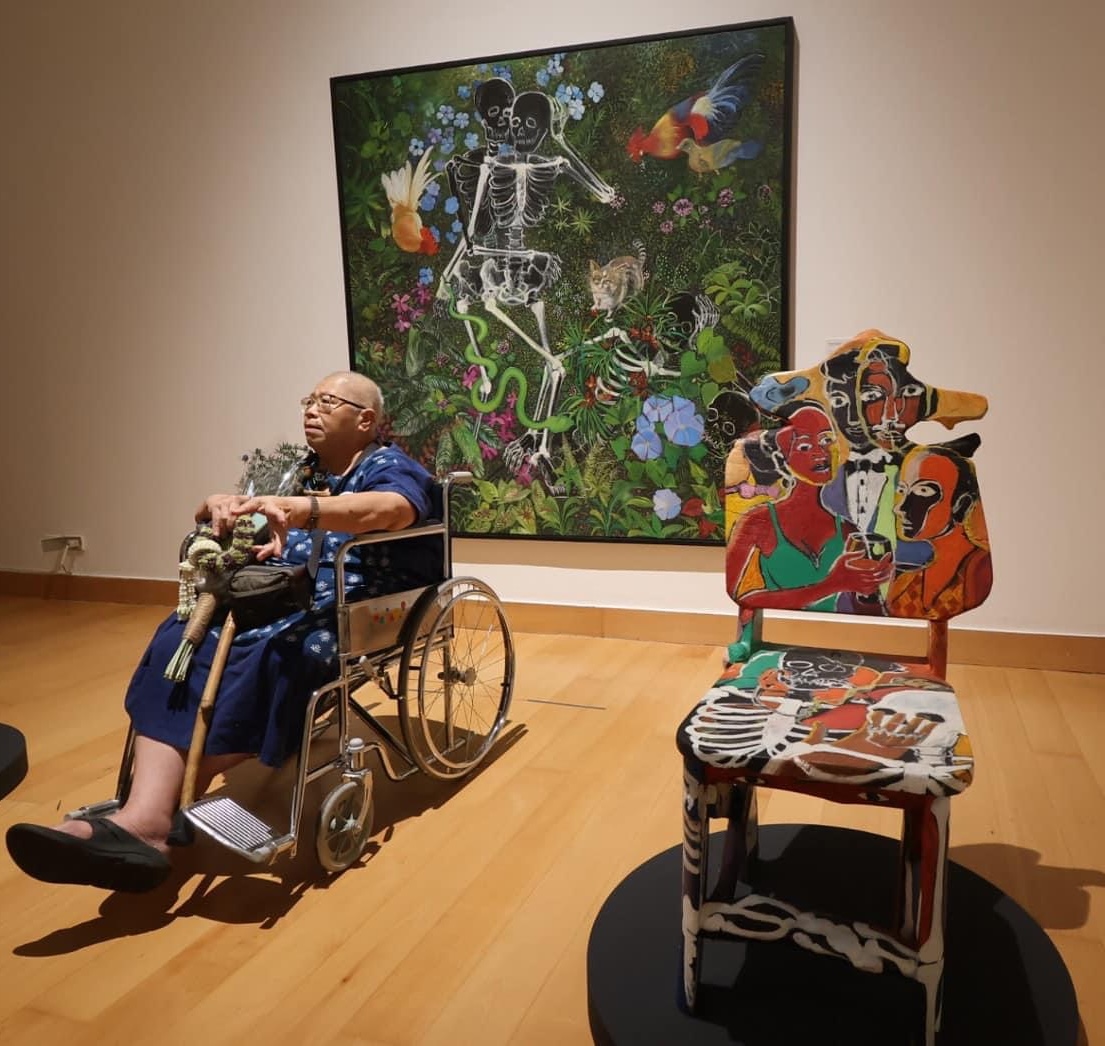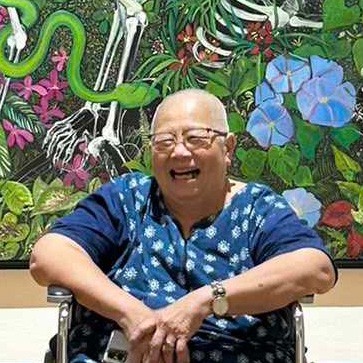Pan Parahom (2482–2557 [1939–2014])
“This land [Boon Bandarn Farm], I feel, is ancient and it was fated that I be here. We are all here too, because it is meant to be. It is because of the land - we are related to the land. This land can educate people.
It is a place where people come from everywhere to get something. In my lifetime I thought of the land of becoming just this – for people to come, and meet and feel joy.”
Pan Parahom, Khun Mae Pan, lived on Boon Bandarn Farm where she experimented with vegetation to make natural dyes for yarn, which she then wove into cloth. She welcomed Womanifesto for the workshop in 2001 and was a participating artist for Womanifesto Residency in 2008.

Tari Ito (1951–2021)
Self-Portrait. Performance. Womanifesto 1997
“Who am I? I’m not married. Who am I? I do not have any children. Who am I? I’m a performer . . . Who am I? I’m a lesbian. Who am I? I’m Tari Ito.”
Me Being Me. Performance. Womanifesto II 1999
“Everybody should be able to live their own lives. My work explores the body and eroticism of a single woman in the face of sexual discrimination and heterosexuality, aiming to create a universal expression.”
“We often hear the expression ‘The personal is the political’ when it comes to discussions on feminism. What happens to a woman’s body does not only concern her, but also the politics and society as a whole. This idea has been my backbone. I’ve been creating, and will continue to create bearing this in my mind.”
Tari Ito, a performance artist, organizer, and activist was an essential part of early Womanifesto projects. Ito came out as a lesbian in her 1996 live performance in Japan - ‘Self-Portrait’, which she then presented at the first Womanifesto exhibition in 1997 at Baan Chao Phraya Gallery in Bangkok, and at Womanifesto II she presented the performance ‘Me Being Me’ in the public space of Saranrom Park. Tari Ito established (1994) the feminist artist collective Women’s Art Network (WAN) in Tokyo, and organized the exhibition “Women Breaking Boundaries” (2001) for which she invited some of the artists she met and befriended at the first two Womanifesto events.

The video documentation of the two performances are from : ‘Self-Portrait’ (1997) at Third Gallery AYA, Osaka, and ‘Me Being Me’ (1999) at Space PRAHA, Sapporo, Japan. Courtesy of IPAMIA (Independent Performance Artists' Moving Images Archive), Japan.
Jiratti Kuttanam (2523–2566 [1980–2023])
"There was nothing recorded on a palm leaf when I was born
Mae told me that…..
Early in the morning, while walking back from giving the daily offerings to monks, she felt pain. The water poured down her legs. At that very moment she knew that I was about to come out to see the world. When she arrived home, she asked dad to call for help. He came back with the neighbours including the midwife. She told mae to lie down on the bamboo bed, bend her knees, open her legs wide and….. push really hard. When my head appeared, she told dad to hand her the kradong – a round woven bamboo tray used for rice – and told mae to push harder and harder. There I was on the kradong. Then she cut the umbilical cord with a well-sharpened bamboo stick and tied it with thread. Dad took the after birth and buried it. Then the midwife threw the kradong up and down lightly to make me cry. After that mae was given the herbal steam treatment for three days following the ancient northeastern tradition that has been handed down from generation to generation to this day. I still don’t know my date of birth."
Jiratti Kuttanam was born in Detch Udom, Ubonratchathani. She was a participating artist and volunteered in administration of projects, notably Womanifesto workshop 2001 and Procreation/Postcreation 2003.
She was a known figure in Bangkok’s art scene, and worked as manager & curator at Artery Gallery Bangkok, Rebel Art Space Bangkok and Street67.
Jiratti’s work shown is the original page from the Procreation/Postcreation publication project.

Jittima Pholsawek (2502–2566 [1959–2023])
ปล่อยให้ฉันร่ายรำ
Let me dance
...
ฉันจะร่ายรำได้อย่างไร
ในเมื่อไฟลุกท่วมหัว
ป่าเขาเผาไหม้ด้วยเพลิงทุน
ฉันจะร่ายรำได้อย่างไร
ขณะที่แม่น้ำสาบสูญ
แผ่นดินเป็นอื่น
ฉันจะร่ายรำได้อย่างไร
ในนครแปลกหน้า
เราต่างอยากฆ่ากัน
ฉันจะร่ายรำได้อย่างไร
ในเมื่อขุนทหารกระชับปืนรายรอบ
กรงเหล็กอ้าประตูรอ
ฉันจะร่ายรำได้อย่างไร
ในเมื่อนิ้วมือถูกบั่น
และท่วงทำนองร่วงหล่นในหลุมดำ
ฉันจะร่ายรำได้อย่างไร...
Let Me Dance
...
How can I dance…
when my head is engulfed with flames
and the forest and mountain are burnt down with capital
How can I dance…
when the river is run to extinction
and the land is made different
How can I dance…
in the city of strangers
people are trying to kill each other
How can I dance…
when soldiers armed with weapons are circling around
and steel cages are open wide waiting
How can I dance…
when my fingers are taken off
and the melody is tuned to the black hole.
How can I dance…
Jittima Pholsawek was an artist, poet, writer, photographer, and activist who worked tirelessly on environmental and social issues. Born in Songkhla and graduated from Changsilpa College, in early years of her career Jittima joined a group of volunteer teachers and worked for children of minorities in the remote countryside of Thailand, including in Chiangrai, Isan and in Southern parts of Thailand. She participated in the exhibition Tradisexion in 1995, from which Womanifesto subsequently emerged. She was part of Womanifesto II in 1999 presenting a performance titled ‘Arrival of Death’ in Saranrom Park, Bangkok, and Procreation/Postcreation—a publication project by Womanifesto in 2003 where she presented a performance for the launch event of the publication at Pridi Banomyong Institute, Bangkok.

Sriwan Janehuttakarnkit (2496–2568 [1953–2025])
'Everything that happens in the world, both good and bad, we should be thankful for and say, “Thank you for coming.”
Happiness, suffering, fear, death, instability, are all part of the transformation and cycle of normal dharma, reflected in our intellect which produces mental images. These works, oil paintings on canvas and on teak chairs, try to capture the beautiful atmosphere of death, and of dying before death.'
Sriwan Janehuttakarnkit was a versatile artist who works across a range of mediums including painting, printmaking, etching, sculpture and ceramics. Her work is inspired by nature, Buddhism, and the human personality. She tried to understand the physical body and emotions by relating these to Buddhist philosophy, where all things are ephemeral and impermanent.
Sriwan graduated with an M.F.A. in Graphics from Silapakorn University, Bangkok in 1979 and a B.F.A. in Graphics (2nd Class Honours) also from Silapakorn University, 1976. She taught art for more than 30 years at various universities in Thailand before establishing her own workspace and gallery in in Chiangsaen, Chiangrai called Sridonmoon Art Space.
Sriwan was actively involved with Womanifesto since 1999, for their second exhibition in Saranrom Park Bangkok. In 2023 she once again joined the group of artists contributing to Womenifesto: Flowing Connections at Bangkok Art and Culture Center.

Related pages
Share a Reflection
log in to share a reflection.
